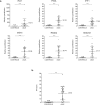Higher interferon score and normal complement levels may identify a distinct clinical subset in children with systemic lupus erythematosus
- PMID: 32334613
- PMCID: PMC7183668
- DOI: 10.1186/s13075-020-02161-8
Higher interferon score and normal complement levels may identify a distinct clinical subset in children with systemic lupus erythematosus
Abstract
Background: Systemic lupus erythematosus (SLE) is a complex multi-system disease, characterized by both autoimmune and autoinflammatory clinical and laboratory features. The role of type I interferon (IFN) in SLE has been demonstrated from the 2000s, by gene expression analyses showing significant over-expression of genes related to type I IFN signalling pathway (IFN signature). However, several studies questioned the role of measuring the intensity of IFN signature (IFN score) to chase SLE activity. We would assess if the IFN signature can help the clinical and therapeutic stratification of patients with pediatric SLE.
Methods: We measured the IFN score in peripheral whole blood from a series of subjects with childhood-onset SLE and correlated the results with clinical and laboratory parameters.
Results: Thirty-one subjects were included in the study, among which the 87% displayed a positive IFN score. The only significant relation was found for high IFN score in subjects with normocomplementemia. No correlation was observed between IFN score and SLEDAI-2K, BILAG-2004 and SLICC. Patients with high IFN score and normal complement levels also presented lower anti-dsDNA antibodies.
Conclusions: The integration between IFN signature analysis and complement levels may easily distinguish two groups of subjects, in which the autoimmune or autoinflammatory component of the disease seems to be prevalent.
Keywords: Autoimmunity; Autoinflammation; Complement; Interferon score; Patients’ stratification; Systemic lupus erythematosus.
Conflict of interest statement
The authors declare that they have no competing interests.
Figures






References
Publication types
MeSH terms
Substances
LinkOut - more resources
Full Text Sources
Medical

